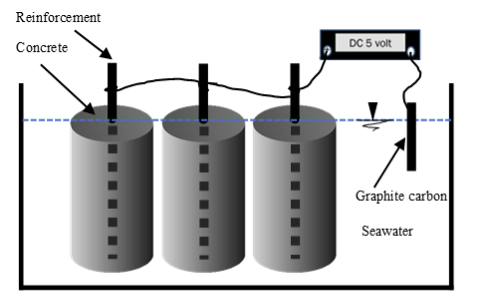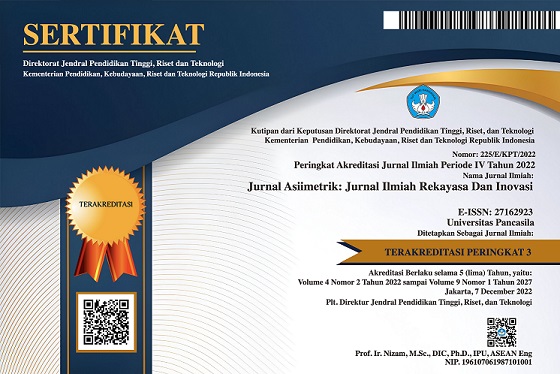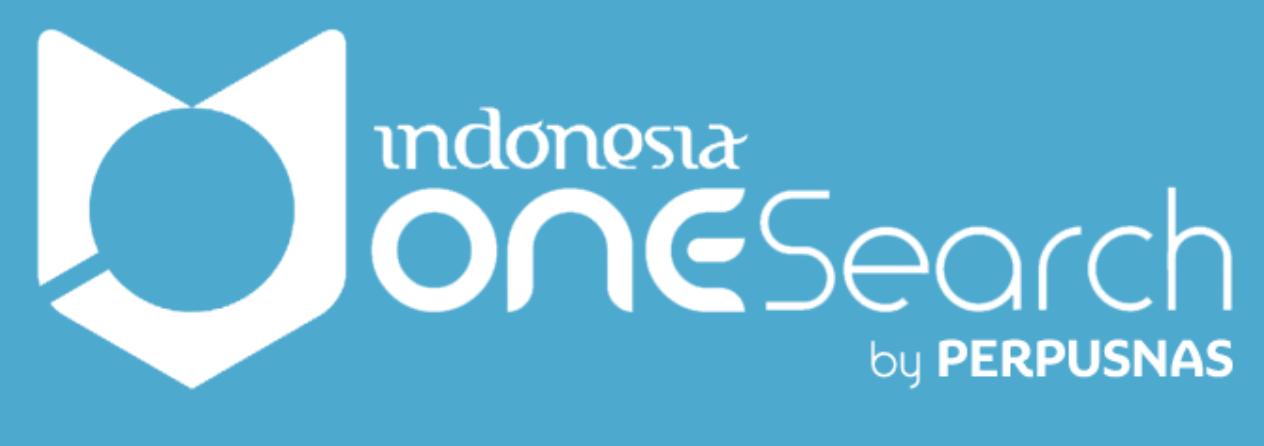Effect of Adding Inhibitors from Dried Tea Leaf Powder and Calcium Nitrate to Concrete and Reinforcement on the Corrosion Rate of Reinforcement and Concrete Compressive Strength
DOI:
https://doi.org/10.35814/asiimetrik.v6i1.5112Keywords:
inhibitor, corrosion, tea leaves, corrosion rate, weight lossAbstract
Indonesia has many coastal areas; sometimes coastal areas have a typical problem like seawater intrusion, causing seawater to be forced to be used as a solution, replacing fresh water in concrete mixtures. However, using seawater can be harmful to the reinforcement because of the chloride ion content in seawater. The result of this study is to determine the effect of seawater on reinforced concrete, as well as examine corrosion inhibitors that can reduce the corrosion rate of concrete reinforcement, the effects of reinforcement on corrosion rate, and the effect of concrete on compressive strength when added inhibitor material. Research method using experimental by making concrete specimens using seawater as a mixing agent for concrete mortar, adding calcium nitrate to it, and in other concrete specimens adding crushed tea leaves. Concrete bar using a plain round reinforcing bar with a diameter of 10 mm and 280 MPa tensile strength. The results of the analysis showed that concrete with a mixture of tea leaves weighing 1.6 kg/m3 of concrete produced the smallest iron weight loss; the largest compressive strength for concrete with inhibitor was produced by concrete specimens with tea leaves weighing 0.8 kg/m3 of concrete.
Downloads
References
Adeyemi, O., F. and Modupeola, A., G. (2014) ‘The Effect of Sea Water on Compressive Strength of Concrete’, International Journal of Engineering Science Invention, 3(7), pp. 23–31.
Al-Amoudi, O.S.B. et al. (2003) ‘Effectiveness of corrosion inhibitors in contaminated concrete’, Cement and Concrete Composites, 25(4), pp. 439–449.
ASTM (2004) ‘ASTM G31-72: Standard Practice for Laboratory Immersion Corrosion Testing of Metals’. Available at: https://www.astm.org/g0031-72r04.html (Accessed: 3 May 2023).
ASTM (2017) ‘ASTM G1-03(2017)e1: Standard Practice for Preparing, Cleaning, and Evaluating Corrosion Test Specimens’. ASTM International. Available at: https://www.astm.org/g0001-03r17e01.html (Accessed: 3 May 2023).
Bouraoui, M.M. et al. (2019) ‘Inhibition Efficiency of Cinnamon Oil as a Green Corrosion Inhibitor’, Journal of Bio- and Tribo-Corrosion, 5(1), p. 28.
BSN (2000) ‘SNI 03-2834-2000: Tata cara pembuatan rencana campuran beton normal’. BSN. Available at: http://sispk.bsn.go.id/SNI/DetailSNI/-CUSTOMER VALUE- (Accessed: 3 January 2022).
BSN (2013) ‘SNI 7974:2013: Spesifikasi air pencampur yang digunakan dalam produksi beton semen hidraulis (ASTM C1602-06, IDT)’. BSN. Available at: http://sispk.bsn.go.id/SNI/DetailSNI/9717 (Accessed: 3 January 2021).
Lamprakou, Z. et al. (2022) ‘Tannin-based inhibitive pigment for sustainable epoxy coatings formulation’, Progress in Organic Coatings, 167, p. 106841.
Lubis, M.F. and Dahlan, D. (2020) ‘Sintesis Lapisan Antikorosi Menggunakan Tanin dari Kulit Batang Bakau sebagai Inhibitor’, Jurnal Fisika Unand (JFU), 9(2), pp. 277–283.
Mangi, S.A. et al. (2021) ‘A Comprehensive Review on Effects of Seawater on Engineering Properties of Concrete’, Silicon, 13(12), pp. 4519–4526.
Nardeli, J.V. et al. (2019) ‘Tannin: A natural corrosion inhibitor for aluminum alloys’, Progress in Organic Coatings, 135, pp. 368–381.
Rahim, A.A. et al. (2008) ‘Inhibitive action of mangrove tannins and phosphoric acid on pre-rusted steel via electrochemical methods’, Corrosion Science, 50(6), pp. 1546–1550.
Rochwulaningsih, Y. et al. (2019) ‘Marine policy basis of Indonesia as a maritime state: The importance of integrated economy’, Marine Policy, 108, p. 103602.
Sanjaya, S. et al. (2019) ‘Pengendalian Laju Korosi Tembaga Pada Media Korosi Larutan NaCL dan HCL Dengan Menggunakan Tanin Daun Jambu Biji Sebagai Green Inhibitor’, Widya Teknik, 18(2), pp. 59–63.
Vorobyova, V. et al. (2023) ‘Quebracho tannin as corrosion inhibitor in neutral media and novel rust conversion agent for enhanced corrosion protection’, South African Journal of Chemical Engineering, 44, pp. 68–80.
Wedhanto, S. (2017) ‘Pengaruh Air Laut Terhadap Kekuatan Tekan Beton yang Terbuat dari Berbagai Merk Semen yang Ada di Kota Malang’, Jurnal Bangunan, 22(2), pp. 21–30.
Xiao, J. et al. (2017) ‘Use of sea-sand and seawater in concrete construction: Current status and future opportunities’, Construction and Building Materials, 155, pp. 1101–1111.
Younis, A. et al. (2018) ‘Fresh and hardened properties of seawater-mixed concrete’, Construction and Building Materials, 190, pp. 276–286.





























